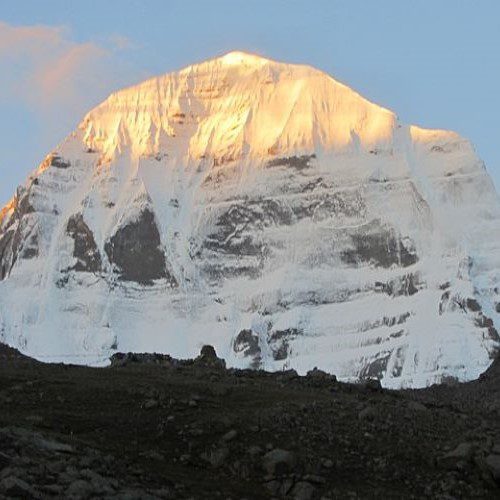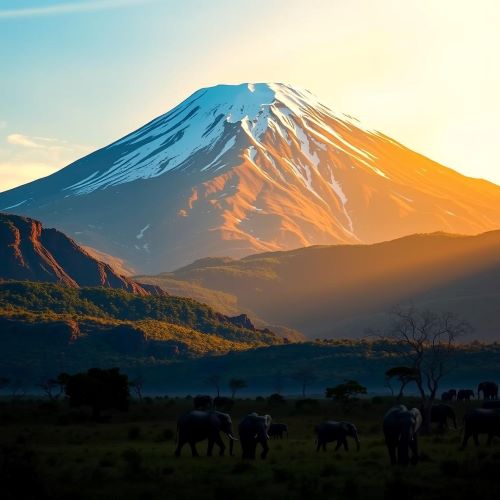Mount Wakakusa : The Burning Mountain
At a glance
| Description | |
|---|---|
| Mythology | Japanese Mythology |
| Country | Japan |
| Closest airport | Osaka International Airport (ITM) |
| Type | Natural |
| Accessibility | 09/10 |
Introduction
Mount Wakakusa, also known as Wakakusayama, rises gracefully behind the historic expanse of Nara Park in Japan. This gently sloping hill offers some of the most stunning panoramic views of Nara City, including sights of Todaiji Temple and the lantern-lined paths of Kasuga Taisha Shrine. While relatively modest in height, Mount Wakakusa holds a monumental place in the hearts of locals and visitors alike. It is not just a scenic landmark but a living testament to the cultural, spiritual, and natural legacy of the region. Its crown jewel is the dazzling Yamayaki Festival, a centuries-old tradition where the mountain’s grassy surface is set ablaze in a captivating spectacle of fire and fireworks every January.
Connection with Mythology
Mount Wakakusa’s spiritual significance is anchored in the legends and traditions that have been passed down through generations. At the top of the mountain lies an ancient burial mound called Uguisuzuka Kofun. Local lore says that this mound was once haunted by restless spirits, stirring unease among travelers and villagers. In an effort to bring peace to these disturbed souls, fires were lit—an act that likely inspired the origin of the mountain’s annual burning ritual. The idea of fire as a spiritual purifier is closely aligned with Shinto beliefs, where flames are seen as tools of renewal and divine communication.
Another tale speaks of a thunder deity and sword-wielding god descending upon Mount Wakakusa while riding a white deer. This story not only adds to the mystical reputation of the mountain but also elevates the sacred status of deer throughout Nara, who are still revered as messengers of the gods. These mythological associations give Mount Wakakusa a unique aura that blends the natural world with divine narrative, creating an immersive spiritual experience for all who visit.
Adding historical dimension to its mythological core is the account of a dispute between two of Nara’s most influential temples, Tōdai-ji and Kōfuku-ji. In 1760, a land disagreement allegedly escalated into the mountain being set on fire—either as a calculated act or an accidental blaze. The memory of this dramatic moment has since evolved into the ritualized Yamayaki Festival, now celebrated to symbolize reconciliation and spiritual cleansing.
Ways to Get There
Reaching Mount Wakakusa is both straightforward and scenic. From Kintetsu Nara Station, the walk to the base of the mountain takes around 25 minutes. This pleasant route winds through the leafy serenity of Nara Park, allowing travelers to pass peaceful ponds, shrines, and the city’s famously tame deer. Those arriving via JR Nara Station can either walk for 40 to 50 minutes or opt for a convenient bus ride to the Kasuga Taisha Shrine stop, which is just a short walk from the mountain.
Public buses run frequently along these routes, with the Nara Kotsu line offering connections between major train stations and the cultural sites near Mount Wakakusa. Driving is also an option, but during festival days, road access may be limited due to heavy foot traffic and safety regulations. At the base of the mountain, visitors are required to pay a modest entrance fee to access the hiking trails that lead to the summit. Two entry points—South Gate and North Gate—are available, spaced roughly 300 meters apart.
What to Look For
Mount Wakakusa’s appeal lies in both its natural charm and cultural offerings. The hill itself consists of three interconnected rises, making the ascent relatively easy for most hikers. The trails are well-maintained and offer a gentle climb that takes about 45 minutes to reach the summit. Along the way, visitors may encounter the free-roaming deer that have become synonymous with Nara, especially near the base where they often interact with tourists and eagerly accept “shika senbei,” or deer crackers.
From the summit, the reward is a sweeping view of Nara City and its historic temples. On clear days, the sightline stretches all the way to the mountains surrounding Kyoto and even Osaka. The elevated perspective adds a sense of grandeur to an already spiritually charged site.
A major draw is the Yamayaki Festival, held every fourth Saturday in January. Beginning with a ceremonial torch procession from Kasuga Taisha Shrine, the event culminates in a spectacular fire that engulfs the hillside in flames. As the fire dies down, an impressive fireworks show lights up the sky. The experience is both mesmerizing and symbolic, reflecting centuries of tradition and a community’s enduring bond with its spiritual past.
Nature lovers will also appreciate the Kasugayama Primeval Forest that borders parts of Mount Wakakusa. This untouched woodland is a designated UNESCO World Heritage Site, recognized for its ecological diversity and pristine beauty. Its ancient trees and wildlife create a tranquil atmosphere, contrasting beautifully with the dramatic energy of the Yamayaki fire ritual.
Need a place to stay? Book your hotel room now!
Importance in cultural history
Mount Wakakusa is much more than a natural hilltop; it is a cornerstone of Nara’s cultural identity. The mountain serves as a powerful emblem of harmony between Shinto and Buddhist philosophies. The annual burning ritual is not merely ceremonial—it is a spiritually symbolic act rooted in purification and renewal. In a broader sense, the event also serves as a metaphor for reconciliation, particularly in reference to the historic feud between Nara’s prominent temples.
From an ecological perspective, the annual controlled burn of Mount Wakakusa plays an essential role in landscape management. It prevents wild overgrowth, minimizes the risk of uncontrolled fires, and rejuvenates the grasses each year, ensuring the mountain retains its rolling green slopes. This integration of ancient wisdom with practical conservation showcases a harmony between tradition and sustainability.
Historically, Mount Wakakusa also reflects the grandeur of the Nara period, when the city served as Japan’s capital. Emperors, poets, and monks frequently turned to the mountain for inspiration and reflection. Its image has been immortalized in classical Japanese literature and visual art, appearing in everything from Edo-period woodblock prints to modern poetry, proving its lasting influence on the country’s cultural imagination.
Best time to travel
Mount Wakakusa offers something unique in every season, and the best time to visit depends on what kind of experience you’re seeking. January is ideal for those hoping to witness the dramatic Yamayaki Festival, although access to the hiking trails is typically restricted during winter months for safety and conservation. For hikers and nature lovers, spring is an excellent choice, with cherry blossoms in full bloom and mild weather making the journey to the summit especially enjoyable.
Autumn transforms the mountain and surrounding forests into a vibrant canvas of red, orange, and gold, offering a picturesque backdrop perfect for photography and outdoor exploration. Summer is also a time of lush greenery, though the warmer temperatures can make the climb more demanding.
Hiking trails are usually open from mid-March to mid-December, allowing visitors to safely enjoy the scenic ascent for most of the year. Each season brings out a different facet of Mount Wakakusa’s personality, ensuring no two visits feel the same.
Source
Hike to Mount Wakakusayama – Rare Photos by Viki Pandit. (2015). Retrieved October 2015, from https://www.vikipandit.com/hike-to-mount-wakakusayama/
Mt. Wakakusa Yamayaki | Travel Japan – Japan. (2020). Retrieved December 2020, from https://www.japan.travel/en/spot/1007/
Mt. Wakakusa (2025) – All You Need to Know BEFORE You Go (with Reviews) – Tripadvisor. (2015). Retrieved March 2015, from https://www.tripadvisor.com/Attraction_Review-g298198-d1137554-Reviews-Mt_Wakakusa-Nara_Nara_Prefecture_Kinki.html
Mount Wakakusa – Must-See, Access, Hours & Price. (2025). Retrieved March 2025, from https://www.gltjp.com/en/directory/item/12130/
Mount Wakakusa | Sightseeing Spots NARA | Kintetsu Railway Co. Ltd. Retrieved 2025, from https://www.kintetsu.co.jp/foreign/english/sightseeing/nara/spot26.html
Wakakusa Mountain Summit Bus[Nara Kotsu]. Retrieved June 2025, from https://japantravel.navitime.com/en/area/jp/railroad/00009614/
Wakakusa Yamayaki – Nara Travel – Japan Guide. (2024). Retrieved December 2024, from https://www.japan-guide.com/e/e4118.html
Frequently Asked Questions
Lorem ipsum dolor sit amet, consectetur adipiscing?
Lorem ipsum dolor sit amet, consectetur adipiscing elit. Praesent convallis vestibulum justo, ac tincidunt nunc vehicula quis. Nullam id dolor quis orci malesuada feugiat. Curabitur aliquet libero at urna ullamcorper, ac ultricies nulla dapibus.
Lorem ipsum dolor sit amet, consectetur adipiscing?
Lorem ipsum dolor sit amet, consectetur adipiscing elit. Praesent convallis vestibulum justo, ac tincidunt nunc vehicula quis. Nullam id dolor quis orci malesuada feugiat. Curabitur aliquet libero at urna ullamcorper, ac ultricies nulla dapibus.
Lorem ipsum dolor sit amet, consectetur adipiscing?
Lorem ipsum dolor sit amet, consectetur adipiscing elit. Praesent convallis vestibulum justo, ac tincidunt nunc vehicula quis. Nullam id dolor quis orci malesuada feugiat. Curabitur aliquet libero at urna ullamcorper, ac ultricies nulla dapibus.
Lorem ipsum dolor sit amet, consectetur adipiscing?
Lorem ipsum dolor sit amet, consectetur adipiscing elit. Praesent convallis vestibulum justo, ac tincidunt nunc vehicula quis. Nullam id dolor quis orci malesuada feugiat. Curabitur aliquet libero at urna ullamcorper, ac ultricies nulla dapibus.
Lorem ipsum dolor sit amet, consectetur adipiscing?
Lorem ipsum dolor sit amet, consectetur adipiscing elit. Praesent convallis vestibulum justo, ac tincidunt nunc vehicula quis. Nullam id dolor quis orci malesuada feugiat. Curabitur aliquet libero at urna ullamcorper, ac ultricies nulla dapibus.








